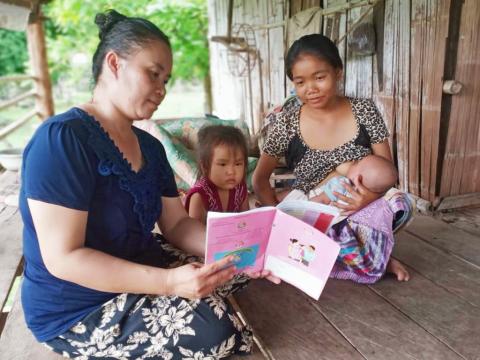When a mother breastfeeds, a child grows healthy

His eyes are blinking, progressively closing. His mouth is still enjoying the milk coming directly from his mother’s breast at a frantic pace. Soon, Airnoy will fall into a deep sleep. The 3-month-old boy will return to his pram made of wood and bamboo, hanging on the roof of a Lao traditional house with two well-tied ropes. While it seems to be a routine, this is indeed a revolution for Airnoy’s family.
Three years ago, Airnoy’s mother Lamphane used to give her first child, Siphonexay, sticky rice and unclean water to drink. “With this practice, mothers were still able to do the work in the field and let other caregivers look after the babies,” says the 22-year-old mother. This has been a common practice countrywide, with less than half of Lao infants (0-5 months) receiving exclusive breastfeeding back in 2017[1], when World Vision was granted the Accelerating Healthy Agriculture and Nutrition (AHAN) Project by the European Union. In Savannakhet province, where Lamphane and her husband Oad live, this figure drops to 43.4%[2].
Old beliefs and customs have been passed through generations among ethnic communities of Southern Laos. However, behaviors are changing. Lives are being transformed.
Led by World Vision, the AHAN Project is working with vulnerable communities to improve their nutrition through an integrated approach with a strong focus on mother and child health. Since 2020, the Mothers’ Nutrition Group, established by AHAN, has encouraged pregnant women and young mothers to meet regularly to understand how the food they eat or give to their children impacts their health and well-being. World Vision staff and local health workers carry on those sessions, supporting over 3,700 mothers of the 124 target villages in their journey to improve the nutrition of their children and families. Since she joined the Mothers’ Nutrition Group of her village, Lamphane used her knowledge through her pregnancy and after the birth of Airnoy, and will know what to feed him after the lactating period. She also learnt how to cook more diversified food for her family and the importance of resting during the first 1,000 days of life of her baby.
To achieve this significant social behavior change, husbands also have an important role to play. Oad has become a great supporter of Lamphane’s breastfeeding, by joining the project activities focused on gender equality. As well as the Mother Groups, World Vision has started to establish Community-Change (C-Change) groups. Across the project target villages, women and men from 3,500 households now have a platform to identify harmful practices related to nutrition and discuss local solutions.
“Joining the C-Change group is a new good step for our family,” says Lamphane.
My husband helps me more with the housework, collecting water, storing the wood, [and] cooking. Now I have the time to breastfeed.
Oad is a careful father, not only helping with housework but also feeding and playing with their daughter Siphonexay, and bringing Airnoy to the outreach clinic visit when the District Health Office staff come to the village every quarter to monitor the growth of the children.
Airnoy, too young to be aware of all this positive change, is waking up from his nap. He’s getting impatient to receive the savory and rich milk provided by her mother. This life-changing ingredient will help him grow strong and healthy, opening up to a brighter future.
[1] Lao Social Indicator Survey LSIS II 2017
[2] AHAN Baseline Survey - 2018